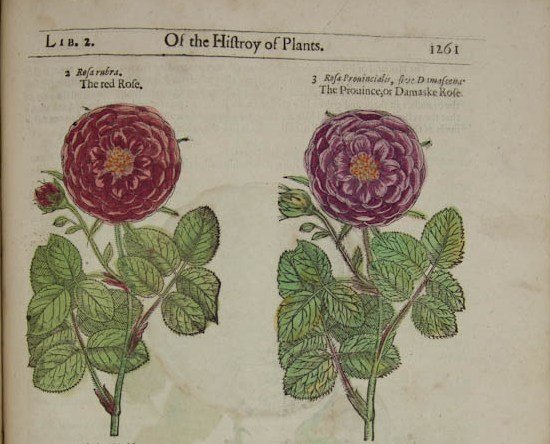Today we turn our thoughts to love... and to flowers. Flowers and love seem to be interconnected throughout history. Roses in particular have romantic associations going back to classical mythology. The red rose was considered to have come about when the petals of a white rose were stained by blood from Venus' cut foot as she ran to help Adonis. It has been suggested that Shakespeare alludes to this in the first lines of Venus and Adonis, when he calls Adonis 'Rose-cheeked Adonis'. This conjures up the classical tale and gives a sense of foreboding as to what is to come. It also suggests that, like flowers, he is all-too mortal.

The idea of flowers being a language is often seen as a Victorian trend, but it was in existence much earlier. Violets are sometimes seen as a sign of modesty, for example when likened to the veined lids of downcast eyes (also in Venus and Adonis). Eglantines (briar roses) were the personal motif of Queen Elizabeth I. Some sources link white roses to secrecy and the briar rose to illicit love.
Shakespeare often uses colloquial names for flowers, perhaps most famously when he uses 'love-in-idleness' (the folk name for the wild pansy or heartsease) - the potent love potion that Puck uses to cause Titania to fall in love with Bottom. His frequent references to plants and flowers have been linked to his Warwickshire upbringing and his attachment to his hometown. The Cuckoo flowers mentioned in King Lear are wild Geraniums, and this is a well-known Stratford name. Find out more about Shakespeare's names for flowers in our Shakespeare Week resources or bring your children along to have a go at this and other activities at our event this weekend.
This blog is far too short to delve into these references, but come along to Heritage Open Days to find out more about flowers in the plays and to see photos of Shakespeare's plays in performance
Let's have a look know at some romantic customs involving flowers:
Tussie-Mussies
Posies, also called tussie-mussies or nosegays, were bundles of extremely fragrant flowers carried on the body, often pinned to bodices. Their pleasing smell was thought to protect against diseases by eliminating bad smells. But they were also simply carried as a beautiful decoration. Popular plants for posies were sweet Williams, roses, rosemary, basil, thyme, rue, hyssop, marjoram, meadow sweet, southernwood and sage. If the carrier was particularly wealthy the rosemary might be gilded as a display of wealth.
They were also used as gifts, communicating a message to the receiver through flower language and the connotations with each type of flower, similar to Ophelia’s flower gifts in Act 4 scene 5. Poetry of the period links lavender to 'lovers true', gillyflowers to 'gentleness', and marigolds to 'marriage'.
Tussie-mussie first appeared in a manuscript as ‘tuzzie muzzie’ in 1033 and then again as ‘tusemose’ in 1440.
Bachelors' Buttons
In The Merry Wives of Windsor there is a reference to Bachelors' Buttons, a colloquial name applied for hundreds of years to many double-petalled, button-like flowers:
Host.
"What say you to young Master Fenton? he capers, he dances, he has eyes of youth, he writes verses, he speaks holiday, he smells April and May; he will carry't, he will carry't; 'tis in his buttons; he will carry't.
Up until Victorian times people continued wearing flowers in their pockets to get an inkling of it their love affairs would prosper. The idea was that if the flower stayed fresh, this boded well. If it faded, this was a bad sign. Gerard links this to the plant Ranunculus aconitifolius fl. pl. (double aconite leaved crowsfoot).
Wedding garlands
See our earlier blog to find out more about wedding garlands.
Interestingly, researching this blog meant finding even more surprising things in the collections. One particular gem is a book entitled "Folk Lore, Old Customes and Superstitions in Shakespeare Land" by Harvey Bloom. This includes local legends such as that of the wart charmer, many unusual uses for snails and a cure for styes that involves rubbing a cat's tail over your eye:
"At Whimpstone in the parish of Whitchurch the great wart-charmer of fifty years ago was one John Day....."
Visit the Reading Room to find out more about local customs and stories!
